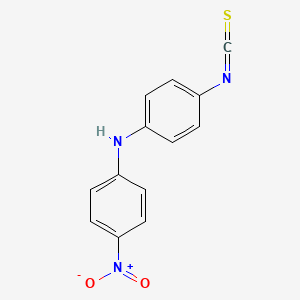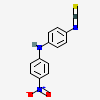Amoscanate
PubChem CID
33488
Molecular Formula
Synonyms
- Amoscanate
- 26328-53-0
- Nithiocyamine
- Amoscanate [INN]
- Amoscanato
Molecular Weight
271.30 g/mol
Computed by PubChem 2.2 (PubChem release 2021.10.14)
Dates
- Create:2005-08-08
- Modify:2025-01-11
Description
Amoscanate is an isothiocyanate that is phenyl isothiocyanate in which the hydrogen at the para- position has been replaced by a 4-nitroanilinyl group. It has a role as a schistosomicide drug. It is a C-nitro compound, an isothiocyanate and a secondary amino compound. It is functionally related to a diphenylamine.
Chemical Structure Depiction

4-isothiocyanato-N-(4-nitrophenyl)aniline
Computed by Lexichem TK 2.7.0 (PubChem release 2021.10.14)
InChI=1S/C13H9N3O2S/c17-16(18)13-7-5-12(6-8-13)15-11-3-1-10(2-4-11)14-9-19/h1-8,15H
Computed by InChI 1.0.6 (PubChem release 2021.10.14)
DKVNAGXPRSYHLB-UHFFFAOYSA-N
Computed by InChI 1.0.6 (PubChem release 2021.10.14)
C1=CC(=CC=C1NC2=CC=C(C=C2)[N+](=O)[O-])N=C=S
Computed by OEChem 2.3.0 (PubChem release 2024.12.12)
C13H9N3O2S
Computed by PubChem 2.2 (PubChem release 2021.10.14)
73201-61-3
- 4-isothiocyanato-4'-nitrodiphenylamine
- 4-isothiocyanato-N-(4-nitrophenyl)benzenamine
- amoscanate
- C 9333-Go
- C-9333-Go
- CGP 4540
- CGP-4540
- nithiocyamine
- nithiocyanamine
- Amoscanate
- 26328-53-0
- Nithiocyamine
- Amoscanate [INN]
- Amoscanato
- Amoscanatum
- 4-isothiocyanato-N-(4-nitrophenyl)aniline
- 100990-46-3
- Ciba 9333 GO
- 4-Isothiocyanato-4'-nitrodiphenylamine
- p-(p-Nitroanilino)phenyl isothiocyanate
- CCRIS 4111
- 4-(4-Nitroanilino)phenylisothiocyanat
- Amoscanatum [INN-Latin]
- Amoscanato [INN-Spanish]
- CGP 4540
- C 9333 GO
- 4-Isothiocyanato-N-(4-nitrophenyl)benzenamine
- GO 9333
- CGP4540
- UNII-X0MK46CVRB
- X0MK46CVRB
- 4-Isothiocyano-4'-nitro diphenylamine
- BRN 0888705
- CHEBI:38944
- AMOSCANATE [MI]
- CGP4540(Amoscanate)
- ISOTHIOCYANIC ACID, p-(p-NITROANILINO)PHENYL ESTER
- Benzenamine, 4-isothiocyanato-N-(4-nitrophenyl)-
- AMOSCANATE [MART.]
- DTXSID90180946
- Amoscanatum (INN-Latin)
- Amoscanato (INN-Spanish)
- AMOSCANATE (MART.)
- Amoscanate; C 9333Go; CGP 4540; CIBA 9333Go
- Benzen-t-amine, 4-isothiocyanato-N-(4-nitrophenyl)-
- Benzenamine, 4-isothiocyanato-N-(4-nitrophenyl)- (9CI)
- nithiocyanamine
- CGP4540(Amoscanate)?
- (4-Isothiocyanato-phenyl)-(4-nitrophenyl)amine
- CHEMBL93385
- SCHEMBL159478
- DTXCID30103437
- C 9333-Go
- C-9333-Go
- GLXC-15403
- CGP-4540
- AKOS040745560
- DA-72126
- MS-23840
- 4-Isothiocyanato-N-(4-nitrophenyl)-aniline
- HY-129051
- CS-0103323
- NS00121034
- G12674
- Q4747973
- Benzenamine, 4-isothiocyanato-N-(4-nitrophenyl)-(9CI)
Property Name
Property Value
Reference
Property Name
Molecular Weight
Property Value
271.30 g/mol
Reference
Computed by PubChem 2.2 (PubChem release 2021.10.14)
Property Name
XLogP3
Property Value
5.2
Reference
Computed by XLogP3 3.0 (PubChem release 2021.10.14)
Property Name
Hydrogen Bond Donor Count
Property Value
1
Reference
Computed by Cactvs 3.4.8.18 (PubChem release 2021.10.14)
Property Name
Hydrogen Bond Acceptor Count
Property Value
5
Reference
Computed by Cactvs 3.4.8.18 (PubChem release 2021.10.14)
Property Name
Rotatable Bond Count
Property Value
3
Reference
Computed by Cactvs 3.4.8.18 (PubChem release 2021.10.14)
Property Name
Exact Mass
Property Value
271.04154771 Da
Reference
Computed by PubChem 2.2 (PubChem release 2021.10.14)
Property Name
Monoisotopic Mass
Property Value
271.04154771 Da
Reference
Computed by PubChem 2.2 (PubChem release 2021.10.14)
Property Name
Topological Polar Surface Area
Property Value
102 Ų
Reference
Computed by Cactvs 3.4.8.18 (PubChem release 2021.10.14)
Property Name
Heavy Atom Count
Property Value
19
Reference
Computed by PubChem
Property Name
Formal Charge
Property Value
0
Reference
Computed by PubChem
Property Name
Complexity
Property Value
349
Reference
Computed by Cactvs 3.4.8.18 (PubChem release 2021.10.14)
Property Name
Isotope Atom Count
Property Value
0
Reference
Computed by PubChem
Property Name
Defined Atom Stereocenter Count
Property Value
0
Reference
Computed by PubChem
Property Name
Undefined Atom Stereocenter Count
Property Value
0
Reference
Computed by PubChem
Property Name
Defined Bond Stereocenter Count
Property Value
0
Reference
Computed by PubChem
Property Name
Undefined Bond Stereocenter Count
Property Value
0
Reference
Computed by PubChem
Property Name
Covalently-Bonded Unit Count
Property Value
1
Reference
Computed by PubChem
Property Name
Compound Is Canonicalized
Property Value
Yes
Reference
Computed by PubChem (release 2021.10.14)
Follow these links to do a live 2D search or do a live 3D search for this compound, sorted by annotation score. This section is deprecated (see here for details), but these live search links provide equivalent functionality to the table that was previously shown here.
Similar Compounds (2D)
Similar Conformers (3D)
Same Count
PubMed Count
Antinematodal Agents
Substances used in the treatment or control of nematode infestations. They are used also in veterinary practice. (See all compounds classified as Antinematodal Agents.)
Filaricides
Pharmacological agents destructive to nematodes in the superfamily Filarioidea. (See all compounds classified as Filaricides.)
Anthelmintics
Agents that kill parasitic worms. They are used therapeutically in the treatment of HELMINTHIASIS in man and animal. (See all compounds classified as Anthelmintics.)
Schistosomicides
Agents that act systemically to kill adult schistosomes. (See all compounds classified as Schistosomicides.)
Patents are available for this chemical structure:
https://patentscope.wipo.int/search/en/result.jsf?inchikey=DKVNAGXPRSYHLB-UHFFFAOYSA-N
- CAS Common ChemistryLICENSEThe data from CAS Common Chemistry is provided under a CC-BY-NC 4.0 license, unless otherwise stated.https://creativecommons.org/licenses/by-nc/4.0/
- ChemIDplusChemIDplus Chemical Information Classificationhttps://pubchem.ncbi.nlm.nih.gov/source/ChemIDplus
- EPA DSSToxCompTox Chemicals Dashboard Chemical Listshttps://comptox.epa.gov/dashboard/chemical-lists/
- FDA Global Substance Registration System (GSRS)LICENSEUnless otherwise noted, the contents of the FDA website (www.fda.gov), both text and graphics, are not copyrighted. They are in the public domain and may be republished, reprinted and otherwise used freely by anyone without the need to obtain permission from FDA. Credit to the U.S. Food and Drug Administration as the source is appreciated but not required.https://www.fda.gov/about-fda/about-website/website-policies#linking
- ChEBI
- ChEMBLLICENSEAccess to the web interface of ChEMBL is made under the EBI's Terms of Use (http://www.ebi.ac.uk/Information/termsofuse.html). The ChEMBL data is made available on a Creative Commons Attribution-Share Alike 3.0 Unported License (http://creativecommons.org/licenses/by-sa/3.0/).http://www.ebi.ac.uk/Information/termsofuse.html
- Human Metabolome Database (HMDB)LICENSEHMDB is offered to the public as a freely available resource. Use and re-distribution of the data, in whole or in part, for commercial purposes requires explicit permission of the authors and explicit acknowledgment of the source material (HMDB) and the original publication (see the HMDB citing page). We ask that users who download significant portions of the database cite the HMDB paper in any resulting publications.http://www.hmdb.ca/citing
- Japan Chemical Substance Dictionary (Nikkaji)
- Metabolomics Workbench
- NCI Thesaurus (NCIt)LICENSEUnless otherwise indicated, all text within NCI products is free of copyright and may be reused without our permission. Credit the National Cancer Institute as the source.https://www.cancer.gov/policies/copyright-reuseNCI Thesaurushttps://ncit.nci.nih.gov
- Springer Nature
- Wikidataamoscanatehttps://www.wikidata.org/wiki/Q4747973
- WikipediaCis-Cyclooctenehttps://en.wikipedia.org/wiki/Cis-CycloocteneAmoscanatehttps://en.wikipedia.org/wiki/Amoscanate
- PubChem
- Medical Subject Headings (MeSH)LICENSEWorks produced by the U.S. government are not subject to copyright protection in the United States. Any such works found on National Library of Medicine (NLM) Web sites may be freely used or reproduced without permission in the U.S.https://www.nlm.nih.gov/copyright.htmlAntinematodal Agentshttps://www.ncbi.nlm.nih.gov/mesh/68000969Filaricideshttps://www.ncbi.nlm.nih.gov/mesh/68005369Anthelminticshttps://www.ncbi.nlm.nih.gov/mesh/68000871Schistosomicideshttps://www.ncbi.nlm.nih.gov/mesh/68012556
- NORMAN Suspect List ExchangeLICENSEData: CC-BY 4.0; Code (hosted by ECI, LCSB): Artistic-2.0https://creativecommons.org/licenses/by/4.0/NORMAN Suspect List Exchange Classificationhttps://www.norman-network.com/nds/SLE/
- MolGenieMolGenie Organic Chemistry Ontologyhttps://github.com/MolGenie/ontology/
- PATENTSCOPE (WIPO)SID 403443582https://pubchem.ncbi.nlm.nih.gov/substance/403443582
CONTENTS

